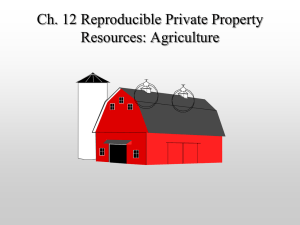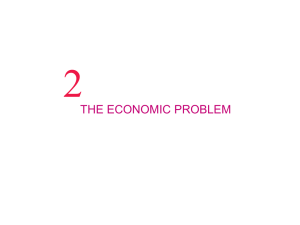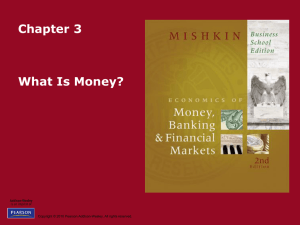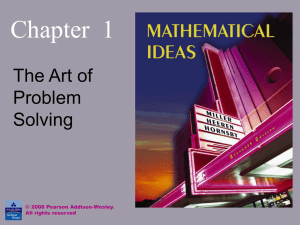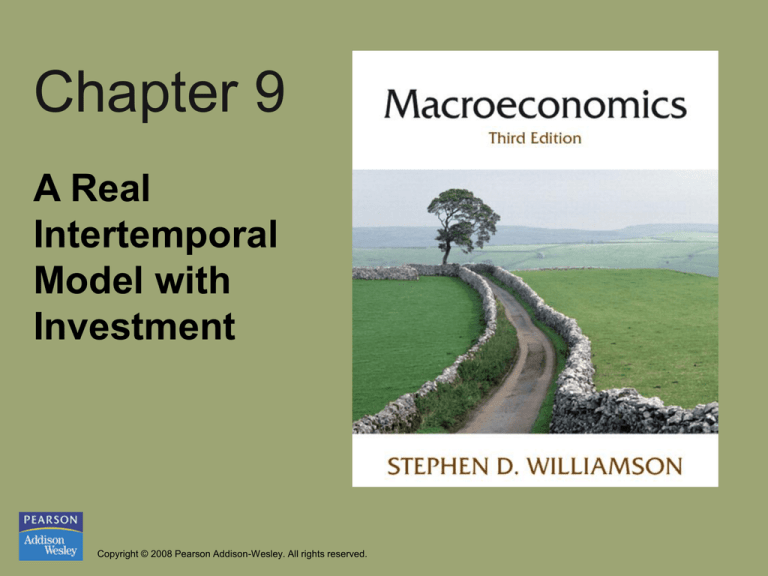
Chapter 9
A Real
Intertemporal
Model with
Investment
Copyright © 2008 Pearson Addison-Wesley. All rights reserved.
Chapter 9 Topics
• Construct a real intertemporal model that will serve as a
basis for studying money and business cycles in
Chapters 10-12.
• Understand the investment decision of the firm.
• Show how macroeconomic shocks affect the economy.
• Focus on the implications of future expectations for
current macroeconomic performance, and the
difference between temporary and permanent shocks.
Copyright © 2008 Pearson Addison-Wesley. All rights reserved.
9-2
Real Intertemporal Model
• Current and future periods.
• Representative Consumer –
consumption/savings decision
• Representative Firm – hires labor and invests in
current period, hires labor in future
• Government – spends and taxes in present and
future, and borrows on the credit market.
Copyright © 2008 Pearson Addison-Wesley. All rights reserved.
9-3
Equation 9.1
Consumer’s current-period budget constraint:
Copyright © 2008 Pearson Addison-Wesley. All rights reserved.
9-4
Equation 9.2
Consumer’s future-period budget constraint:
Copyright © 2008 Pearson Addison-Wesley. All rights reserved.
9-5
Equation 9.3
Consumer’s lifetime budget constraint:
Copyright © 2008 Pearson Addison-Wesley. All rights reserved.
9-6
Equation 9.4
Consumer’s current-period marginal condition:
Copyright © 2008 Pearson Addison-Wesley. All rights reserved.
9-7
Equation 9.5
Consumer’s future-period marginal condition:
Copyright © 2008 Pearson Addison-Wesley. All rights reserved.
9-8
Equation 9.6
Consumer’s intertemporal marginal condition:
Copyright © 2008 Pearson Addison-Wesley. All rights reserved.
9-9
Consumer’s Current Labor
Supply Behavior
• Current labor supplied increases with the real
wage (substitution effects are assumed to
dominate income effects).
• Labor supply increases with an increase in the
real interest rate, through an intertemporal
substitution effect.
• An increase in lifetime wealth (e.g. taxes fall)
reduces labor supply.
Copyright © 2008 Pearson Addison-Wesley. All rights reserved.
9-10
Figure 9.1 The Representative
Consumer’s Current Labor Supply
Curve
Copyright © 2008 Pearson Addison-Wesley. All rights reserved.
9-11
Figure 9.2 An Increase in the Real
Interest Rate Shifts the Current Labor
Supply Curve to the Right
Copyright © 2008 Pearson Addison-Wesley. All rights reserved.
9-12
Figure 9.3 Effects of an Increase
in Lifetime Wealth
Copyright © 2008 Pearson Addison-Wesley. All rights reserved.
9-13
Equation 9.7
Firm’s current-period production function:
Copyright © 2008 Pearson Addison-Wesley. All rights reserved.
9-14
Equation 9.8
Firm’s future-period production function:
Copyright © 2008 Pearson Addison-Wesley. All rights reserved.
9-15
Equation 9.9
Evolution of the firm’s capital stock:
Copyright © 2008 Pearson Addison-Wesley. All rights reserved.
9-16
Equation 9.10
Firm’s current-period profits:
Copyright © 2008 Pearson Addison-Wesley. All rights reserved.
9-17
Equation 9.11
Firm’s future-period profits:
Copyright © 2008 Pearson Addison-Wesley. All rights reserved.
9-18
Equation 9.12
The firm maximizes the present value of profits,
Copyright © 2008 Pearson Addison-Wesley. All rights reserved.
9-19
The Firm’s Labor Demand
As in Chapter 4, the firm’s labor demand schedule
is the marginal product of labor for the firm,
which is downward sloping.
Copyright © 2008 Pearson Addison-Wesley. All rights reserved.
9-20
Figure 9.4 The Demand Curve for Current
Labor Is the Representative Firm’s Marginal
Product of Labor Schedule
Copyright © 2008 Pearson Addison-Wesley. All rights reserved.
9-21
Figure 9.5 The Current Demand Curve for Labor
Shifts Due to Changes in Current Total Factor
Productivity z and in the Current Capital Stock K
Copyright © 2008 Pearson Addison-Wesley. All rights reserved.
9-22
The Representative Firm’s
Investment Decision
The firm invests to the point where the marginal
benefit from investment equals the marginal
cost.
Copyright © 2008 Pearson Addison-Wesley. All rights reserved.
9-23
Equation 9.13
The marginal cost of investment is 1, as the firm
gives up one unit of current profits for each unit
it invests, so:
Copyright © 2008 Pearson Addison-Wesley. All rights reserved.
9-24
Equation 9.14
The marginal benefit of investment is the marginal
product of future capital plus the quantity of
capital that will be left in the future after
depreciation, all discounted back to the present:
Copyright © 2008 Pearson Addison-Wesley. All rights reserved.
9-25
Equation 9.15
The firm’s optimal investment rule, obtained by
equating the marginal benefit and marginal cost
of investment:
Copyright © 2008 Pearson Addison-Wesley. All rights reserved.
9-26
Equation 9.16
Simplified optimal investment rule:
Copyright © 2008 Pearson Addison-Wesley. All rights reserved.
9-27
Figure 9.6 Optimal Investment
Schedule for the Representative Firm
Copyright © 2008 Pearson Addison-Wesley. All rights reserved.
9-28
Figure 9.7 The Optimal Investment Schedule Shifts to
the Right if Current Capital Decreases or Future Total
Factor Productivity Is Expected to Increase
Copyright © 2008 Pearson Addison-Wesley. All rights reserved.
9-29
Table 9.1 Data for Christine’s
Orchard
Copyright © 2008 Pearson Addison-Wesley. All rights reserved.
9-30
Equation 9.17
Copyright © 2008 Pearson Addison-Wesley. All rights reserved.
9-31
Figure 9.8 The Relative Price
of Housing
Copyright © 2008 Pearson Addison-Wesley. All rights reserved.
9-32
Figure 9.9 Residential Construction as
a Percentage of GDP
Copyright © 2008 Pearson Addison-Wesley. All rights reserved.
9-33
Equation 9.18
The government’s present-value budget constraint:
Copyright © 2008 Pearson Addison-Wesley. All rights reserved.
9-34
Figure 9.10 Determination of Equilibrium
in the Labor Market Given the Real
Interest Rate r
Copyright © 2008 Pearson Addison-Wesley. All rights reserved.
9-35
Figure 9.11 Construction of
the Output Supply Curve
Copyright © 2008 Pearson Addison-Wesley. All rights reserved.
9-36
Figure 9.12 An Increase in Current or
Future Government Spending Shifts
the Ys Curve
Copyright © 2008 Pearson Addison-Wesley. All rights reserved.
9-37
Figure 9.13 An Increase in Current
Total Factor Productivity Shifts the Ys
Curve
Copyright © 2008 Pearson Addison-Wesley. All rights reserved.
9-38
Equation 9.19
Total demand for output equals demand for
consumption goods plus demand for investment
goods, plus demand for goods from government:
Copyright © 2008 Pearson Addison-Wesley. All rights reserved.
9-39
Equation 9.20
Determining the total effect on the change in
demand of an exogenous change in expenditure
on goods.
Copyright © 2008 Pearson Addison-Wesley. All rights reserved.
9-40
Equation 9.21
The “multiplier.”
Copyright © 2008 Pearson Addison-Wesley. All rights reserved.
9-41
Figure 9.14 The Output
Demand Curve
Copyright © 2008 Pearson Addison-Wesley. All rights reserved.
9-42
Figure 9.15 A Shift in the
Output Demand Curve
Copyright © 2008 Pearson Addison-Wesley. All rights reserved.
9-43
Figure 9.16 The Complete
Real Intertemporal Model
Copyright © 2008 Pearson Addison-Wesley. All rights reserved.
9-44
Experiments Using the Real
Intertemporal Model
•
•
•
•
•
G increases temporarily.
G increases permanently.
K decreases.
z increases.
z’ increases.
Copyright © 2008 Pearson Addison-Wesley. All rights reserved.
9-45
Temporary Increase in
Government Purchases
• Output increases, real interest rate increases, real
wage falls, consumption and investment
decrease, employment rises.
• Government spending crowds out both
consumption and investment.
Copyright © 2008 Pearson Addison-Wesley. All rights reserved.
9-46
Figure 9.17 A Temporary Increase in
Government Purchases
Copyright © 2008 Pearson Addison-Wesley. All rights reserved.
9-47
Permanent Increase in
Government Purchases
• Output increases by the amount of the increase
in government spending.
• No change in the real interest rate, investment
and consumption unchanged, real wage falls,
employment rises.
• No crowding out of C and I, but leisure falls for
the consumer.
Copyright © 2008 Pearson Addison-Wesley. All rights reserved.
9-48
Figure 9.19 Natural Log of
Real Investment, 1929–2005
Copyright © 2008 Pearson Addison-Wesley. All rights reserved.
9-49
Figure 9.18 A Permanent Increase in
Government Expenditures
Copyright © 2008 Pearson Addison-Wesley. All rights reserved.
9-50
A Decrease in the Current
Capital Stock
• This could arise due to a war or natural disaster.
• Output may rise or fall, depending on how large
the output demand effect is relative to the output
supply effect.
• The real interest rate rises, the real wage falls,
employment may rise or fall.
Copyright © 2008 Pearson Addison-Wesley. All rights reserved.
9-51
Figure 9.20 The Equilibrium Effects of a
Decrease in the Current Capital Stock
Copyright © 2008 Pearson Addison-Wesley. All rights reserved.
9-52
Current Total Factor
Productivity Increases
• Real interest rate falls, consumption and
investment rise, employment rises, real wage
rises.
• Productivity shocks are a potential explanation
for business cycles – see Chapter 11.
Copyright © 2008 Pearson Addison-Wesley. All rights reserved.
9-53
Figure 9.21 The Equilibrium Effects of an
Increase in Current Total Factor
Productivity
Copyright © 2008 Pearson Addison-Wesley. All rights reserved.
9-54
Total Factor Productivity
Expected to Increase in Future
• Output demand curve shifts right.
• Real interest rate rises, investment increases,
consumption may rise or fall, employment rises,
real wage falls, output rises.
• Important in explaining investment boom in the
1990s.
Copyright © 2008 Pearson Addison-Wesley. All rights reserved.
9-55
Figure 9.22 The Equilibrium Effects of
an Increase in Future Total Factor
Productivity
Copyright © 2008 Pearson Addison-Wesley. All rights reserved.
9-56
Figure 9.23 Percentage Deviations
From Trend in GDP and Investment,
1990–2006
Copyright © 2008 Pearson Addison-Wesley. All rights reserved.
9-57
Figure 9.24 Investment as a
Percentage of GDP, 1990–2006
Copyright © 2008 Pearson Addison-Wesley. All rights reserved.
9-58
Figure 9.25 S and P 500
Stock Price Index, 1990–2005
Copyright © 2008 Pearson Addison-Wesley. All rights reserved.
9-59



